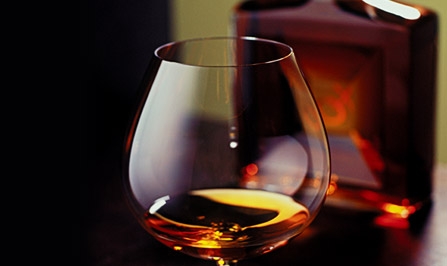Brandy is a very diverse spirit seen in many forms across the world. It can be made from a range of fruits like apples and grapes, from sugar cane (some say rum is actually Brandy) and from a long list of herbs and spices. Many of the liqueurs drunk world wide are brandy-based like, Benedictine D.O.M., Chartreuse, Chambord, Cointreau and Grand Marnier. Often brandy is infused and further distilled to create common spirits. Cognac, Armagnac, Aguardiente, Marc, Grappa and Pisco are all forms of Brandy as well.
[related_content slugs=”write-drunk-edit-sober-gin-and-tonic,write-drunk-edit-sober-steelbach-cocktail,write-drunk-edit-sober-the-manhattan” description=”More Write drunk; edit sober” position=”right”]
The word “brandy” is derived from a dutch term meaning “burned (distilled) wine”. Brandy now describes any spirit distilled from a specific fruit, but it stretches even further to mean a neutral brandy spirit base that is flavoured with fruit and sometimes sweetened.
Cognac is the most famous and well-known of the brandies and is the ultimate maxim to which all others aspire. Produced only in the Cognac region in France, Cognac can only be made from the grapes from vineyards in specific French districts. Cognac is made from a combination of white grapes that produce an acidic white wine perfect for distilling. The Cognac region is divided into six areas, all which produce different qualities of the spirit.
Cognac is double distilled in a traditional pot still. The first distillation produces a 60 proof spirit that is cloudy and off-putting. The second distillation produces a 140 proof spirit that is clear. Before bottling Cognac is usually watered down to around 80 proof. Cognac is then aged for anywhere between two years and forty years in oak casks. As the spirit ages it is transferred to new casks every couple years.
The finest Cognacs come from two regions; Grande Champagne and Petite Champagne. Not surprisingly, grapes from these regions are the same grapes used to make Champagne. Followed by Borderies and Fins Bois, where most cognac world-wide is made. Bons Bois produces lower quality Cognac and Bois Ordinaries produces the lowest quality.
To know how long cognac is aged for, one must look at the stars on the bottle. One star means 3 years, two stars mean 4 years and three or more stars mean 5 years and up. These stars are usually followed by abbreviations that connote the quality of the spirit.
V.S. – Very Special
V.O. – Very Old
V.S.O.P – Very Superior Old Pale
V.V.S.O.P. – Very Very Special Old Pale
X.O. – Extra Old
Different distillers assign names to further designate their best premium Cognacs such as Extra orNapoleon X.O. Usually these additions mean extra aged but they do not specify a certain age. They usually do represent a premium quality in vague terms though.
Typically the rule for Cognac is the more letters and stars on a bottle, the better it will be. Some famous Cognac brands include: Remy Martin, Hine, Courvoisier, Martell and Hennessy.
Cognac is best enjoyed neat in a brandy snifter. Allow your hand to lightly warm the drink to release its “bouquet” before drinking.
Cognac of lower qualities can be enjoyed in cocktails. Some say that brandy was originally used in the Sazerac cocktail, making it the quintessential spirit from which all mixed drinks were built.
The Pisco Sour Cocktail might be the most commonly drunk brandy cocktail.
Cheers,
Pisco Sour Cocktail
2 oz Pisco brandy
3/4 oz fresh lemon juice
1/4 oz simple syrup
1 egg white
Garnish: Maraschino cherry
Shake the egg white alone in the cocktail shaker to aerate it. Combine all other ingredients in the shaker. Shake vigorously over ice and strain into a chilled coup glass. Garnish with the cherry.
